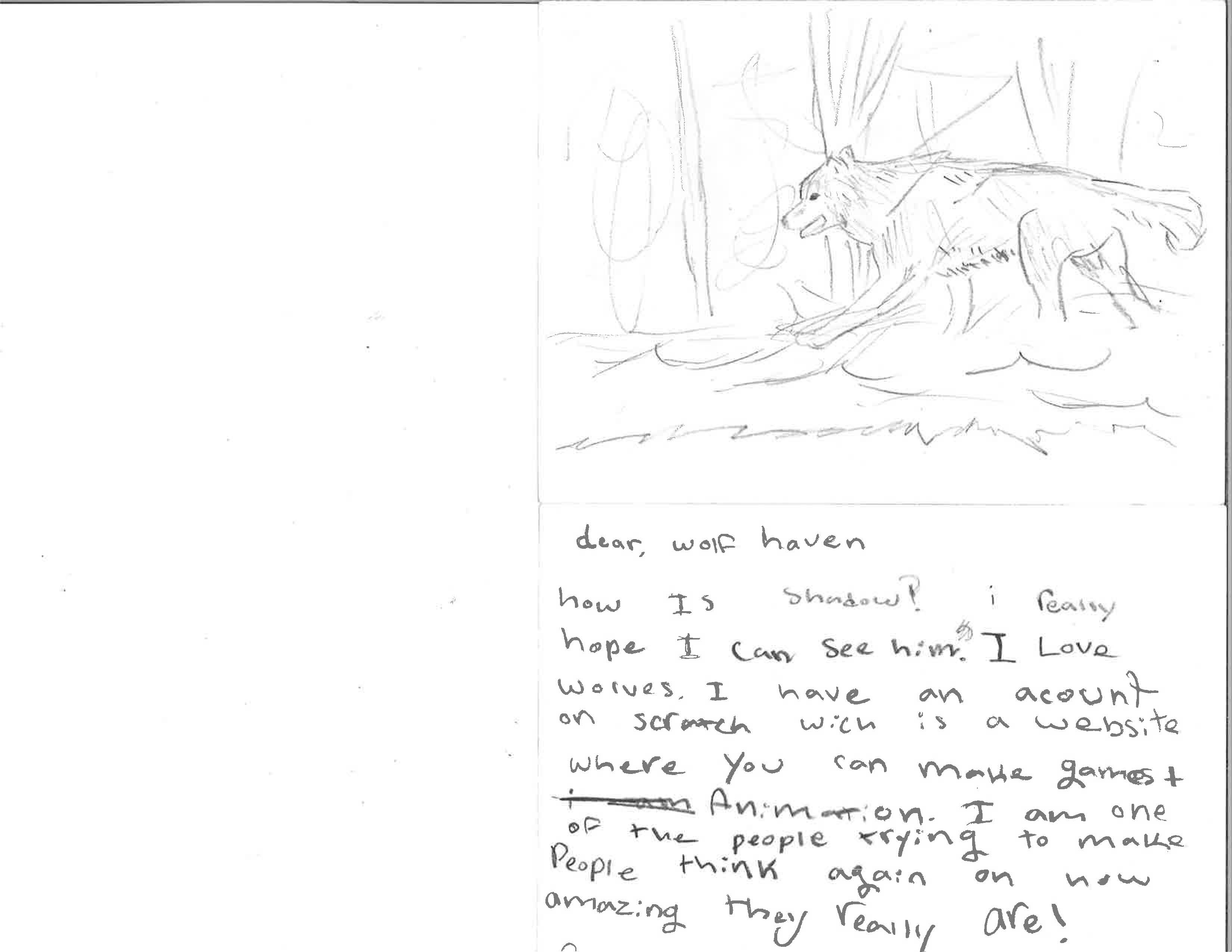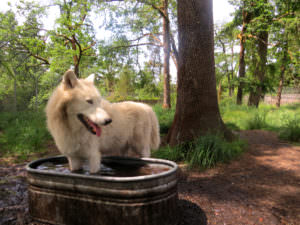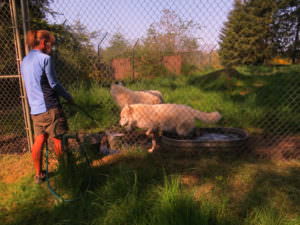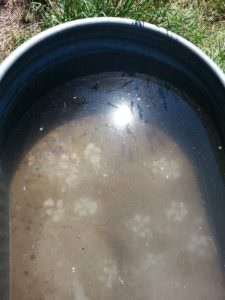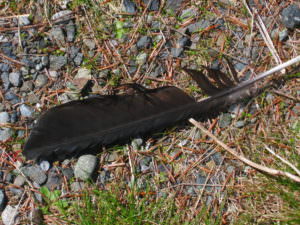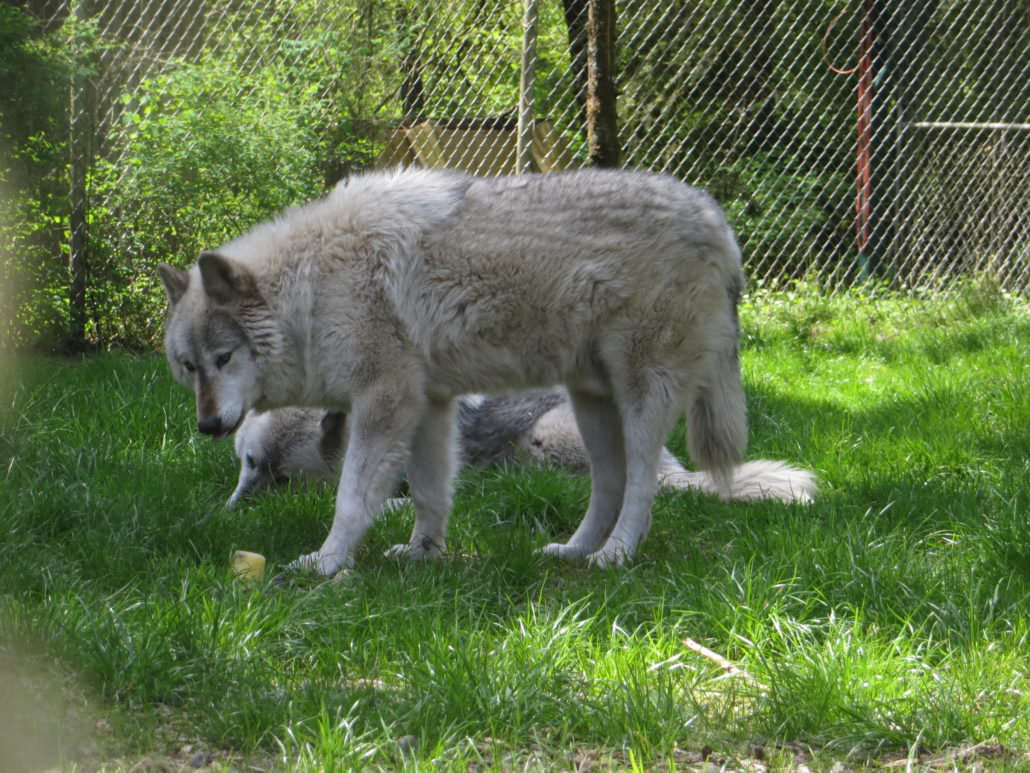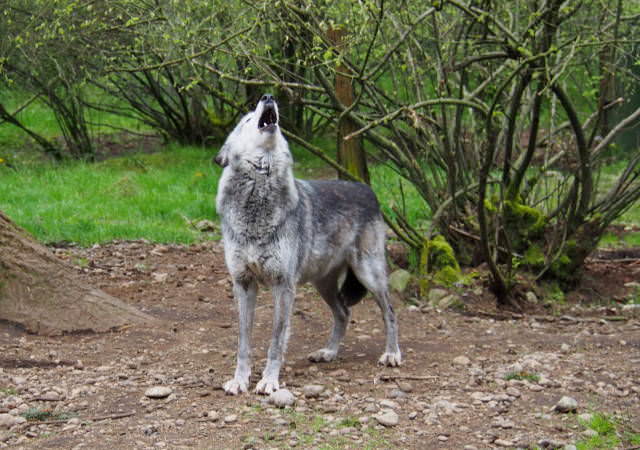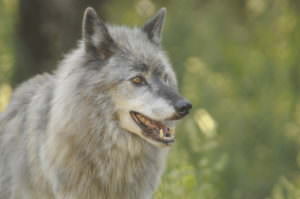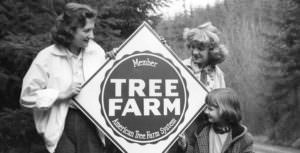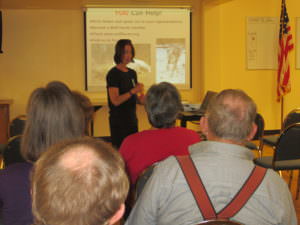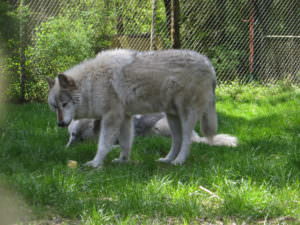Mowing at The Haven
by Brennan Stoelb, Animal Care Specialist
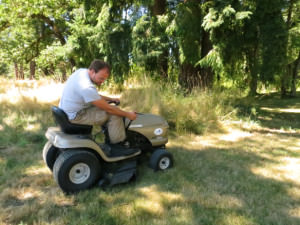 The Pacific Northwest is known for its rainy days, but the summer usually brings lots of sun. As you might guess, this is a great recipe for plants to grow, more specifically, grass. The animal care staff tries to mow the grass in the sanctuary on the footpaths outside of the enclosures on Tuesdays, since we are closed for visits. Our mowing routine is nothing out of the ordinary; one person cuts the roads with the rider mower, two people weed whack closer to the fences and around obstacles. As with everything that needs to get done in the sanctuary, we do it with the animal’s well-being and comfort as the top priority.
The Pacific Northwest is known for its rainy days, but the summer usually brings lots of sun. As you might guess, this is a great recipe for plants to grow, more specifically, grass. The animal care staff tries to mow the grass in the sanctuary on the footpaths outside of the enclosures on Tuesdays, since we are closed for visits. Our mowing routine is nothing out of the ordinary; one person cuts the roads with the rider mower, two people weed whack closer to the fences and around obstacles. As with everything that needs to get done in the sanctuary, we do it with the animal’s well-being and comfort as the top priority.
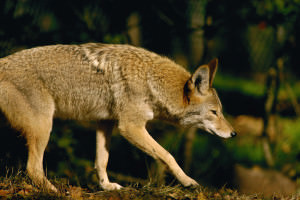 Wolves are neophobic, or afraid of new things. Unlike dogs, wolves are not very brave and outgoing when it comes to new things in their environment. Coyotes are braver than wolves which is why they have been so successful integrating with people and our urban ways. So when it comes to cutting grass, you would expect our residents to stay away from us and the mowers. Guess again! There seems to be two reactions to mowing day; indifference, and curiosity.
Wolves are neophobic, or afraid of new things. Unlike dogs, wolves are not very brave and outgoing when it comes to new things in their environment. Coyotes are braver than wolves which is why they have been so successful integrating with people and our urban ways. So when it comes to cutting grass, you would expect our residents to stay away from us and the mowers. Guess again! There seems to be two reactions to mowing day; indifference, and curiosity.
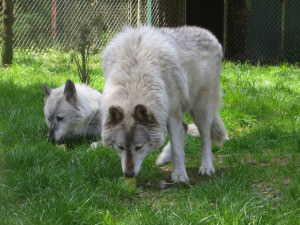 Indifference. There are some residents that just don’t seem to care that the animal care staff is operating loud machinery. Indifference is mostly manifested by them continuing to lie on the ground or carrying on with their normal routine. Some indifferent wolves include Jesse and Shiloh and Mehina and Klondike.
Indifference. There are some residents that just don’t seem to care that the animal care staff is operating loud machinery. Indifference is mostly manifested by them continuing to lie on the ground or carrying on with their normal routine. Some indifferent wolves include Jesse and Shiloh and Mehina and Klondike.
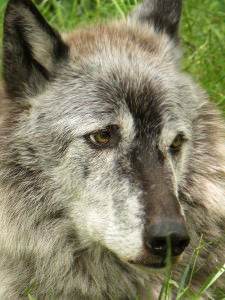 Curiosity. This is the reaction most residents have and it baffles me. Mowing day is met not with fear, but active interest. Even skittish animals seem to have a newfound bravery when the mower is around. Since Shoka arrived at the sanctuary, he has been wary of me. I catch glimpses of him and hear huffs as I walk past during feeding or doing the walkthrough. I do what needs to be done and I move on. But just this morning as I was on the rider mower, I went past Shoka’s enclosure and he was about five feet away from the fence just watching. No huffing. No running to the back of the enclosure. Just watching.
Curiosity. This is the reaction most residents have and it baffles me. Mowing day is met not with fear, but active interest. Even skittish animals seem to have a newfound bravery when the mower is around. Since Shoka arrived at the sanctuary, he has been wary of me. I catch glimpses of him and hear huffs as I walk past during feeding or doing the walkthrough. I do what needs to be done and I move on. But just this morning as I was on the rider mower, I went past Shoka’s enclosure and he was about five feet away from the fence just watching. No huffing. No running to the back of the enclosure. Just watching.
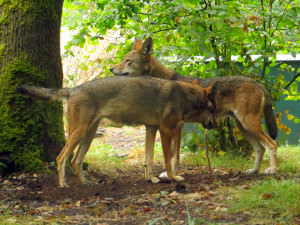 Red wolves Ruby and Tala, while hard to see on visits, are often at the fence in full view while we are mowing the grass. Same goes for the coyotes. Some wolves like Lonnie, will rub the fence line after the mower or weed whacker has passed to get the fresh-cut grass smell. After all, who doesn’t like that?
Red wolves Ruby and Tala, while hard to see on visits, are often at the fence in full view while we are mowing the grass. Same goes for the coyotes. Some wolves like Lonnie, will rub the fence line after the mower or weed whacker has passed to get the fresh-cut grass smell. After all, who doesn’t like that?
Splish Splash
by Brennan Stoelb, Animal Care Specialist, Wolf Haven International
In a recent blog I mentioned that it has been hot here in western Washington. Read it here…… While on most hot days the wolves lay in the shade to keep cool, Wolf Haven also provides other means to beat the heat; splash tubs.
For the animals that enjoy wading in water, animal care places 45 gallon, galvanized tanks in their enclosure. Not every enclosure has a tank because, just like humans, not every wolf likes to get wet. The tubs are about a foot and a half tall, just enough to be below their stomachs. They’ll jump in the tub and begin pawing the water to make it splash. Lakota and Shadow are two residents who love their tubs.
As you might assume, all this playing in the tub can make for some messy water. Every week animal care scrubs the tubs and replaces the dirty water with clean. In some cases the water will be changed more frequently. Daily we top-off the tubs to replace any water that’s been splashed out. With sponges and diluted bleach in hand, we go about the task of cleaning. Not only does dirt and fur cloudy up the water, it’s not uncommon to see someone peeing in their tub. Nothing is better than filling a tub with cool, clean water, only to have them hop in and pee – to each his own, as they say. Sometimes during feeding, a piece of meat will fall the wrong way and land in the tub.
One day when I was feeding a treat to Lakota, a piece fell in the tub. Not to let a little water stand in his way, Lakota stuck his head in the water, over his eyes, and sort of “bobbed” for his treat. Unfortunately, he was unsuccessful. I threw him a replacement, which he ate, but he went back to the tub and pawed the surface of the water, ever hopeful that it may float to the surface.
It surprises some people to hear that wolves can swim. They have webbing between their toes to help them move more easily on snow and uneven surfaces. This webbing also helps when swimming. Wolves will cross streams while chasing prey but
photographers captured one young wolf in Canada swimming to catch a goose. Perhaps his “rubber ducky?”
On Lake Superior in northern Michigan there is an island called Isle Royale. Once connected by a predictable ice bridge in the winter, Isle Royale has become a subject of recent debate. Home to a 56 year study on moose and wolf interactions, the island’s wolves are in decline. According to the annual report, there are nine wolves on the island, two of which are female. Scientists are concluding that the decline is a result of inbreeding both in prey and predator, since no new genetics are regularly coming to the island. To get to the island, wolves would have to swim about 15 miles. In 1997, a wolf from Canada affectionately called, “The old grey guy,” crossed the ice bridge and became a successful breeder. The debate amongst scientists is whether humans should intervene by bringing new genes to the island or let nature take its course. For more information on Isle Royale visit www.isleroyalewolf.org.
So if the heat gets to you this summer, do what the wolves do – and take a dip!
I Hear the Birds A-Cawin’
by Brennan Stoelb, Animal Care Specialist, Wolf Haven International
When it comes to the noises of the human world, Wolf Haven is fairly quiet. Mild traffic, the occasional police or fire siren, and the hum of a nearby train are often the only indications that urban life is around. The wolves know it too and will sing along with the passing siren. We are fortunate to be serenaded by a chorus of 51 wolves for other reasons too, like the sight of the feeding truck. But wolves aren’t the only animals you will hear at Wolf Haven.
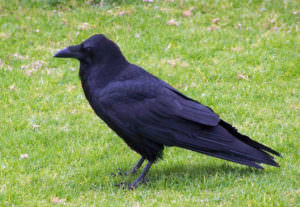
Raven
If you look into the trees you will likely see our friendly neighbors in the sky, ravens.
Before there were wolves at Wolf Haven, there were no resident ravens. In the wild, wolves and raven have a close working relationship. When wolves make a kill, the ravens will feed on the carcass once the wolves leave. Likewise, raven activity on a carcass alerts wolves to a meal they can scavenge when times are tight. Some also say that ravens “tell” wolves where a herd of ungulates are located, so the wolves can make the kill and in turn, feed the ravens.
The relationship between wolves and ravens seems to go beyond survival. Scientists have even observed what appears to be wolves and raven engaged in play. Ravens will sometimes bomb the wolves, grabbing tufts of fur or they will be seen swooping down, staying just out of jaws reach. While I cannot attest to viewing wolves and ravens playing at Wolf Haven, I have certainly seen ravens take food that didn’t quite make it to the wolves. I have also seen ravens that didn’t make it back to the trees….if you catch my drift.
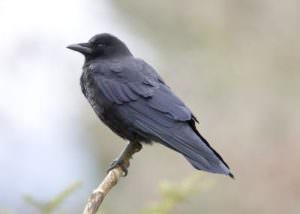
American Crow photo by Rod Gilbert
We also have a small number of crows here at Wolf Haven. Crows and ravens are part of the corvid family. While very similar, ravens have bigger features and are more solitary. Recently as a part of staff enrichment, we gathered to watch the PBS documentary, A Murder of Crows. This documentary focused on the intelligence of crows and their ability to problem-solve, with one study showing crows are capable of multi-level thinking, such as getting a smaller stick to retrieve a bigger stick to finally get food. Astonishingly, crows also have 250 distinct calls and can recognize a human face, based on positive or negative experiences, for up to two years. They will scold those that have done them wrong in the past, alerting others to the danger.
As I type, I can hear the caws of both ravens and crows amongst the silence. I can only wonder what they’re saying.
(Special thanks to volunteer and bird expert Treesa Hertzel for maintaining the Wolf Haven bird watch report and “Birds of Wolf Haven page for our website.)
The Heat is On
by Brennan Stoelb, Animal Care Specialist
The last Wolf Haven blog I wrote dealt with the increasing daylight causing not only wolves, but other animals as well, to shed. The shedding is due to more Prolactin being produced by their bodies in response to the increasing daylight. Most of the residents at Wolf Haven have completed this year’s shedding. And it’s just in time!
A quick glance at the thermometer, which is in the shade outside of the animal care
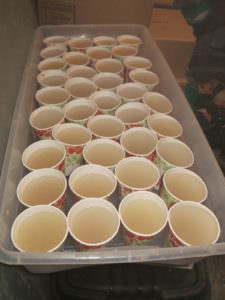
Freezing tunasicles for a hot day
office, showed the needle at a warm 90 degrees. Other than feeding and changing the water for our residents, we aren’t doing much in the sanctuary today. It doesn’t mean there isn’t grass to cut or other tasks to perform, but they can wait until the heat passes. There is no need to make anyone run around or move for that matter, any more than they want to.
Coincidental, today is Tuesday and we aren’t open for visits. If the temperatures are too high, we will cancel visits for human and animal safety alike. Last year I gave a visit to a friend of mine who just happened to give blood earlier in the day. That combined with the heat was enough to make her get light-headed and need to be wheelchaired out of the sanctuary. Stay hydrated and please – engage in no acts of kindness that require liquids to be removed from your body prior to your visit (by all means, give blood after).
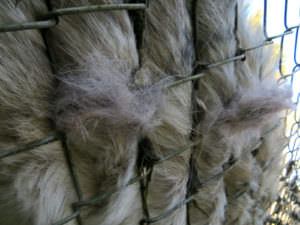
Klondike shedding some of his unnecessary fur
So what do wolves do on a day like today? The same as you probably wish you were doing; lie in the shade and stay cool. The residents are often not too active on hot days. Often people who come on a visit do so because they are fascinated by wolves and want to see them. Unfortunately, sometimes you see more tall grass on a hot day than you do wolves. My best advice for visit times in the summer is a morning visit; that way you have a better chance to see and learn about wolves. Oh, and if you’re so inclined, give blood later in the day.
A Picture (and Sound) Worth a Thousand Words
by Wolf Haven volunteer Greg Wellsandt
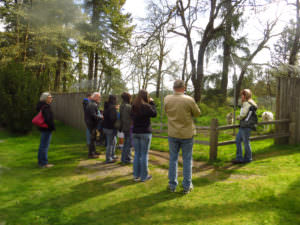
Volunteer Traci leads a group through the sanctuary
On Saturday, Wolf Haven volunteer visit guide Traci was giving the first visit of the day, assisted by her flip chart turner, Greg (that’s me). At Enclosure #5, a howl started way out in the off-visit area. It took a long time to gain momentum, but soon the whole gang was fully engaged in the music making. Caedus and Ladyhawk put on a show at the front of their enclosure as did Klondike and Mehina.
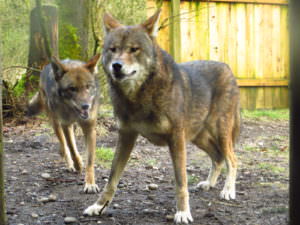
Ruby and Tala, red wolves
Ruby and Tala even made an appearance to lend their unique voices. The howl went on for a long time much to the delight of the visitors who were snapping photos and recording the sounds. Finally, Ladyhawk had enough. She decided it was time to shut Caedus up because she was in the mood to play. She bent over in a quasi-submissive pose and attempted to get his attention. When that didn’t work, she tried to grab his jaw to stop the howling. Caedus gave it a thought for a moment, but went back to what he loves almost as much as eating, howling.
Ladyhawk was not to be deterred and continued to try to get Caedus’s attention. Finally, the howl started to diminish and the two became engaged in a bit of gentle roughhousing. Our sanctuary visitors were treated to a wonderful live display of wolf communication.
The gift of adoption
One way that Wolf Haven raises both funds AND awareness is by offering symbolic adoptions of our resident wolves (and wolfdogs and two coyotes). Adoption levels begin at only $25. You receive a beautiful, professional 4 x 6″ matted photo, an adoption certificate and an official biography of the animal selected.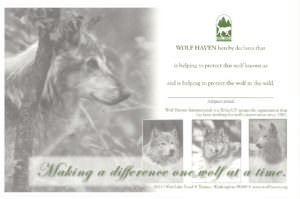
They are also given as gifts; one gentleman routinely “adopts” all of the animals at the sanctuary (50+) for his wife as her Christmas gift. And she LOVES it.
Food For Thought
Skie Bender – Education Outreach Specialist
Weaving my old truck through Capitol Forest towards the small timber town of Montesano, (population 3,500) the cobalt blue sky gives way to a rolling mass of gray. Montesano, birthplace of tree farming, became the nation’s first tree farm in 1941.
At 11 a.m. I arrive at the Montesano Library ready to share my passion and knowledge of wolves with the citizens. Once a week the Montesano Library hosts an adult lunch time program appropriately titled, Food For Thought. People pack a lunch from home and bring it to the library where they enjoy eating while listening to the speaker of the week.
Today Wolf Haven has been chosen as speaker of the wee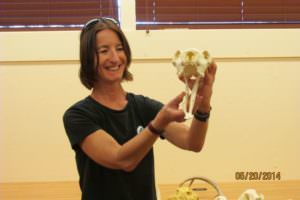 k, and I am the mouthpiece. Crunching apples, chewy cheese sandwich and sips from soda can sounds filled the room as I began the wolf talk with a long streamline hooooowwwwl. Masticating mouths froze. Breaths held still. Ears pricked up.
k, and I am the mouthpiece. Crunching apples, chewy cheese sandwich and sips from soda can sounds filled the room as I began the wolf talk with a long streamline hooooowwwwl. Masticating mouths froze. Breaths held still. Ears pricked up.
Once I completed the howl, I allowed for a moment of silence.Then asked everyone to imagine that they bought a “get-away” cabin for the purpose of“getting-back-to-nature”. No TV. No computer. No phone. No technological distractions.Only pure primal sounds like the wind blowing, leaves rustling, trees creaking, wild animals moving deliberately through the underbrush, and the snap-flap of a hawks wide strong wings.
I continue. “It is dusk. You peacefully sit outside on the porch of your cabin feeling at one with the nature that surrounds you. Then one forlorn howl rises over the west hills, that solitary howl is soon joined by another and another, until there is a surround sound of howls, each varying in tone and inflection.
The next morning you go into town to the General Store to buy some supplies. You discreetly ask the cashier, ‘Are there wolves around here?’ She answers, ‘Oh yes, Lots of Wolves.’ Other folks in the store overhear and chime in, ‘This is wolf central. You are in wolf country. There are more packs here than anywhere else in the country.’ ”
Returning to Library consciousness – I ask the group – “How does this make you feel?” Greatly appreciating the candid answers, a few of the responses I get are:
“Less adventurous about exploring areas around my new cabin.”
“Worried for my dogs.”
“Excited about the wolf packs around me.”
“I won’t let my children play in the woods.”
“Exhilarated!”
I begin the slideshow, which is primarily about wolves in Washington State, but delves into general wolf issues such as the historic and current ranges of wolves, species of wolves, wolf/livestock conflict and management. As always at these presentations there are an array of questions that range from scientific to philosophical.
Between you and me – The best part about being the teacher/speaker is how much I get to learn!
Tuna Popsicle
by Brennan Stoelb, Animal Care Specialist
We have had some warm days already this year with more to follow, no doubt. I remember the sound of an ice cream truck during the hot summer days, sending me on a risky adventure through the couch cushions for any loose change that my parents unknowingly donated to the cause.
Summer is a good time at Wolf Haven. On hot days, it’s not uncommon to see the
wolves lounging in the shade or to notice maybe just an ear flicker in the tall grass. They like to take it easy. We are always trying to keep their senses and minds interested with items that they don’t get on a regular basis. One such item is tuna popsicles. While we don’t have the catchy music of an ice cream truck, we’d like to think the popsicles are greeted with as much enthusiasm.
You may be thinking, “Where I can buy a tuna popsicle?” Good question, and to the best of my knowledge you can’t. We purchase disposable cups, enough for all the animals here, and we buy some tuna. We put a generous amount of tuna in the cup and fill the rest with water. We then put the cups in the freezer. Presto! Tuna popsicles.
Now we don’t limit the wolves’ culinary pallets to just tuna. We like to mix things up for the wolves. As part of our Sustainable Selections program, we sometimes get things like shrimp from the food vendor. We put the shrimp in and then add some minced garlic for extra tastiness.
Check out the VIDEO of EVE enjoying her popsicle!

